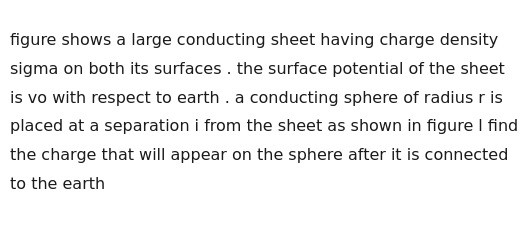Question
Question: figure shows a large conducting sheet having charge density sigma on both its surfaces . the surface...
figure shows a large conducting sheet having charge density sigma on both its surfaces . the surface potential of the sheet is vo with respect to earth . a conducting sphere of radius r is placed at a separation i from the sheet as shown in figure l find the charge that will appear on the sphere after it is connected to the earth

4πR(σL - ε₀V₀)
Solution
The problem describes a large conducting sheet with charge density σ on both its surfaces, and its surface potential is V0 with respect to Earth. A conducting sphere of radius R is placed at a distance L from the sheet and is then connected to Earth. We need to find the charge that appears on the sphere.
Let's assume the large conducting sheet is a thin sheet located at x=0. The charge density on each surface is σ. Thus, the total surface charge density of the sheet is 2σ. The electric field produced by a large conducting sheet with total surface charge density Σtotal is E=2ϵ0Σtotal. In this case, Σtotal=2σ, so the electric field outside the sheet (for x>0) is E=2ϵ02σ=ϵ0σ. The field is directed away from the sheet if σ>0.
The potential at a distance x>0 from the sheet is given by V(x)=V(0)−∫0xEdx. We are given that the surface potential of the sheet is V0, so V(0)=V0. V(x)=V0−∫0xϵ0σdx=V0−ϵ0σx. This formula is valid for x>0.
A conducting sphere of radius R is placed at a separation L from the sheet. The figure indicates that L is the distance from the sheet to the center of the sphere. So, the center of the sphere is located at x=L.
When the sphere is connected to Earth, its potential becomes 0. Since the sphere is a conductor in electrostatic equilibrium, the potential is constant everywhere inside and on the surface of the sphere, and this potential is 0. Let's consider the potential at the center of the sphere.
The potential at the center of the sphere (at x=L) is the sum of the potential due to the charged sheet and the potential due to the charge induced/present on the sphere. The potential at x=L due to the charged sheet is Vsheet(L)=V0−ϵ0σL.
Let q be the total charge that appears on the sphere. This charge q distributes itself on the surface of the sphere. The potential at the center of the sphere due to the charge q on the sphere (even in the presence of the external field from the sheet) is the same as the potential at the center of an isolated sphere with charge q, which is 4πϵ0Rq. This is because the potential inside a conductor is constant, and the potential at the center due to the charge on the sphere is equal to the potential on the surface due to that charge, which is kq/R.
So, the total potential at the center of the sphere is the sum of the potential due to the sheet and the potential due to the charge on the sphere: Vtotal(L)=Vsheet(L)+Vsphere_charge(L). Since the sphere is connected to Earth, its potential is 0. Thus, the potential at its center is also 0: Vtotal(L)=0.
Substituting the expressions for the potentials: (V0−ϵ0σL)+4πϵ0Rq=0.
Now, we solve for the charge q: 4πϵ0Rq=ϵ0σL−V0. q=4πϵ0R(ϵ0σL−V0). q=4πϵ0R(ϵ0σL−ϵ0V0). q=4πR(σL−ϵ0V0).
This is the charge that will appear on the sphere after it is connected to the Earth.
